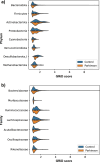Metagenome-assembled microbial genomes from Parkinson's disease fecal samples
- PMID: 39143178
- PMCID: PMC11324757
- DOI: 10.1038/s41598-024-69742-4
Metagenome-assembled microbial genomes from Parkinson's disease fecal samples
Abstract
The human gut microbiome composition has been linked to Parkinson's disease (PD). However, knowledge of the gut microbiota on the genome level is still limited. Here we performed deep metagenomic sequencing and binning to build metagenome-assembled genomes (MAGs) from 136 human fecal microbiomes (68 PD samples and 68 control samples). We constructed 952 non-redundant high-quality MAGs and compared them between PD and control groups. Among these MAGs, there were 22 different genomes of Collinsella and Prevotella, indicating high variability of those genera in the human gut environment. Microdiversity analysis indicated that Ruminococcus bromii was statistically significantly (p < 0.002) more diverse on the strain level in the control samples compared to the PD samples. In addition, by clustering all genes and performing presence-absence analysis between groups, we identified several control-specific (p < 0.05) related genes, such as speF and Fe-S oxidoreductase. We also report detailed annotation of MAGs, including Clusters of Orthologous Genes (COG), Cas operon type, antiviral gene, prophage, and secondary metabolites biosynthetic gene clusters, which can be useful for providing a reference for future studies.
Keywords: Ruminococcus bromii; Metagenome; Microdiversity; Parkinson’s disease.
© 2024. The Author(s).
Conflict of interest statement
FS: Grants from The Academy of Finland, The Hospital District of Helsinki and Uusimaa, OLVI-Foundation, Konung Gustaf V:s och Drottning Victorias Frimurarestiftelse, The Wilhelm and Else Stockmann Foundation, The Emil Aaltonen Foundation, The Yrjö Jahnsson Foundation, The Sigrid Jusélius Foundation, Renishaw. Honoraria: AbbVie, Axial Biotherapeutics, Orion, GE Healthcare, Merck, Teva, Bristol Myers Squibb, Sanofi, Biocodex, Lundbeck, and Biogen. Founder and CEO of NeuroInnovation Oy and NeuroBiome Ltd. Member of the advisory boards of Axial Biotherapeutics and MRM Health. Stock options from Axial Biotherapeutics. P.A.B.P., L.P., P.A., and F.S. have patents issued (FI127671B, US10139408B2, US11499971B2) and pending (US16/186,663, EP3149205) that are assigned to NeuroBiome Ltd. T.K.S. is funded by Novo Nordisk Foundation (NNF22OC0080109).
Figures





Similar articles
-
Novel Insights into the Pig Gut Microbiome Using Metagenome-Assembled Genomes.Microbiol Spectr. 2022 Aug 31;10(4):e0238022. doi: 10.1128/spectrum.02380-22. Epub 2022 Jul 26. Microbiol Spectr. 2022. PMID: 35880887 Free PMC article.
-
A catalog of microbial genes and metagenome-assembled genomes from the quail gut microbiome.Poult Sci. 2023 Oct;102(10):102931. doi: 10.1016/j.psj.2023.102931. Epub 2023 Jul 9. Poult Sci. 2023. PMID: 37499616 Free PMC article.
-
Expanded catalog of microbial genes and metagenome-assembled genomes from the pig gut microbiome.Nat Commun. 2021 Feb 17;12(1):1106. doi: 10.1038/s41467-021-21295-0. Nat Commun. 2021. PMID: 33597514 Free PMC article.
-
Recovering metagenome-assembled genomes from shotgun metagenomic sequencing data: Methods, applications, challenges, and opportunities.Microbiol Res. 2022 Jul;260:127023. doi: 10.1016/j.micres.2022.127023. Epub 2022 Apr 8. Microbiol Res. 2022. PMID: 35430490 Review.
-
Genome-resolved metagenomics using environmental and clinical samples.Brief Bioinform. 2021 Sep 2;22(5):bbab030. doi: 10.1093/bib/bbab030. Brief Bioinform. 2021. PMID: 33758906 Free PMC article. Review.
Cited by
-
Comparison of phage and plasmid populations in the gut microbiota between Parkinson's disease patients and controls.Sci Rep. 2025 Apr 21;15(1):13723. doi: 10.1038/s41598-025-96924-5. Sci Rep. 2025. PMID: 40258842 Free PMC article.
-
Discovery of a phylogenetically novel tropical marine Gammaproteobacteria elucidated from assembled genomes and the proposed transfer of the genus Umboniibacter from the family Cellvibrionaceae to Umboniibacteraceae fam. nov.Front Microbiol. 2025 Mar 28;16:1437936. doi: 10.3389/fmicb.2025.1437936. eCollection 2025. Front Microbiol. 2025. PMID: 40226095 Free PMC article.
References
MeSH terms
Grants and funding
LinkOut - more resources
Full Text Sources
Medical
Miscellaneous

